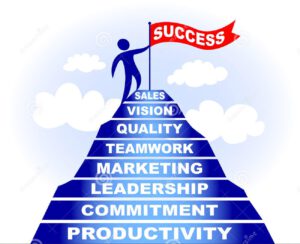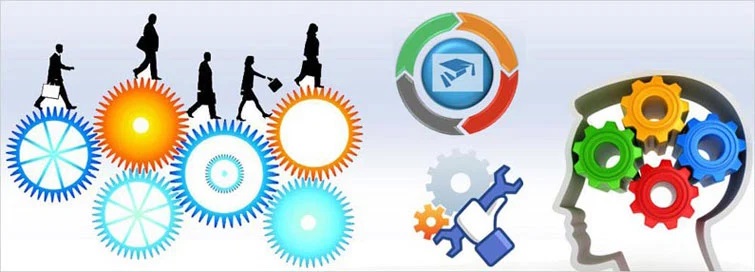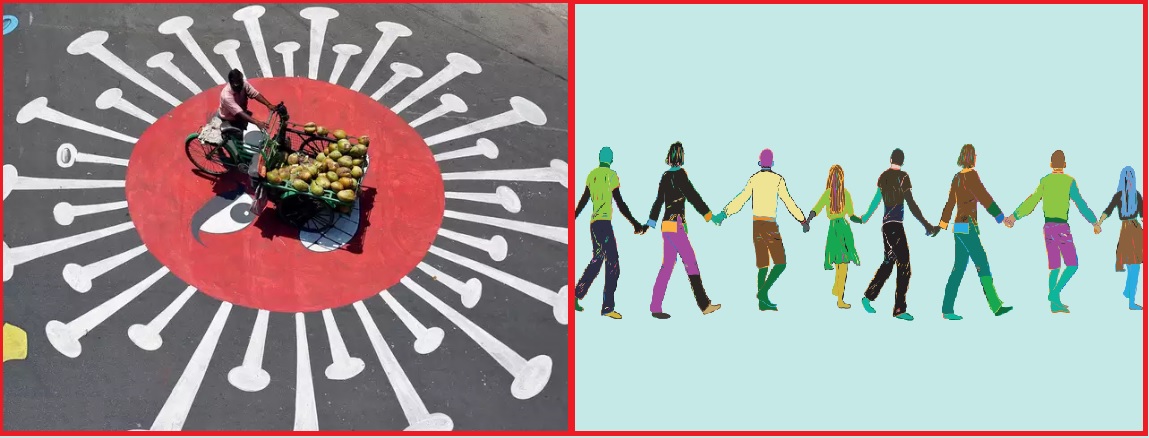CAPACITY BUILDING AND COVID 19 Introduction: Post- COVID 19 period is being viewed by the economists and management pundits as opening of new opportunities along with new challenges and threats to the Indian economy. In this context, role of Government, entrepreneurs, management personnel, and supporting manpower has become more responsible and dutiful with changing vision and mission of their respective organizations and human capital. Government plays a role like a ring master to take lead in boosting economy. Entrepreneurs’ role is defined to create wealth with new business ideas and social responsibilities. They develop leadership excellence to overcome the challenges and threats and converting them into new opportunities in global perspective. They will need to re-assess the business environment, create new work culture in context with global competitiveness, and Work from Home (WFH) culture. No doubt, local and traditional demands will be fulfilled by micro entrepreneurs, but going beyond geographical and political boundaries new business ideas will be one of the key issues for promoting and sustaining their businesses. Management and professional personnel will have higher degree of challenges due to emergence of new technologies, and advance management practices which are to be adopted by their counterparts working in different parts of the world. Supportive manpower in the organizations will be required to upgrade their knowledge and skill so as to deliver goods as per prescribed standards effectively and efficiently. Non-commitment and ignorance in the network, and system will cause loss of credibility, brand images, industrial unrest, low salary, poor amenities and welfare, and ultimately resulting into low productivity, frustration and damage of work culture.
Situation after COVID 19: In context with emerging situation after COVID 19, it will be prime task of the top management to provide and upgrade knowledge, skill and professionalism in human resource in the organization. New technologies will rapidly develop to cater the needs of emerging new trends of demands of the customers. Business scenario due to decline of buying capacity, health consciousness, insurance, health, need of rapid employment at mass scale, growth of agricultural outputs, aviation, defense etc will require dedicated, smart, punctual, alert, and ambitious persons who can create yield and benefits to the companies
How to cope with new situation: . Capacity building is now an important step for enhancing higher productivity and profitability of the organization. It is now necessary to understand the concept, process and strategy of capacity building.
Capacity building is a process of upgrading and improving knowledge, skill and capabilities of individual, organization, network and system for their continuous growth and development. Capacity can be built up in the following areas of operation. These are:
- Governance,
- Knowledge and Skill Development and Management,
- Planning and development,
- Performance measurement,
- Communication and presentation,
- Organizational system and Policies,
- Networking and business support mechanism,
- System development,
- Financial management,
- Risk/Crisis management,
- Ecosystem and organizational culture,
- Nature and Environment,
- Advocacy Skill,
- Leadership excellence,
- Strategic formulation.
Process of Capacity Building: Capacity building is a continuous process at work which should focus on the following four major points.
- Focus on what matters:
(i). Define Success, (ii). Setting Priorities (iii). Make effective Self-Management
- Develop Allies:
(i). Building a Network, (ii). Nurture your Network
- Achieve Results
(i). Project Management. (ii). Problem Solving, (iii). Negotiating, and (iv). Presentation and Communication Style
- Integrated Thinking:
(i). Identifying Opportunities for Change, (ii). Managing and Communicating Change
- Focus on what matters:
Individual’s success is finally organization’s success. Every individual works hard to achieve success in his/her different stages of life. For this, he/she needs to develop passion and commitment to achieve desired success. Successful persons are those who make things happen. So, first step on capacity building process is to define success. (i). Define Success: For defining the success, following steps may be considered: Step-1: Think what success means to you. Step-2: Set a time to achieve success. Step-3: Set your values, goals and purpose of your success. Step-4: Study in depth the nature of job which you are to perform. Step-5: Study the stakeholders/surroundings/environment of the work which you are to attend. Step-6: Assess that you are good at the work to build your strength. Step-7: Decide what contribution you can make. Step-7: Keep your imagination free from any prejudice and mental blockades. Step-8: Assess your work what you are doing that should not deviate from your path of success. Step-9: Put you success statement in writing and always refer and evaluate it. Once you define your success, prepare a picture of your success. Always keep monitoring and evaluating the progress made in achieving success.
(ii). Setting Priorities: Priorities are identified to prepare framework for self-management and putting first things first.
a). Framework for Self-Management: An individual spends time purposefully when the wok is important and urgent and Wastes his/her time when he/she meets the other’s need (refer table-1).

Source: Capacity Building Workshop, Participant Handbook, DC-MSME/GIZ, May 2014
b). Putting first things first:
- Write down your priorities on notes and checklist,
- Plan and prepare to do.
iii. Develop Planning, prioritizing and controlling mechanism at your own level.
- Provide highest quality of life.
For becoming effective self-manager, the task should be implemented carefully by following three steps: Organize Act and Evaluate.
- Develop Allies: A manager cannot work to achieve desired result without support of others. He/ She develops a network of allies on which he/she relies while executing the work.He/She executes the work by (i).Managing his/her boss,(ii).Working collaboratively with his/her colleagues, and (iii).Delegating to subordinates.
(I). Building a Network: Building a network is strengthening yourself to perform the work to achieve desired success. He/She gains a lot of information, ideas, and feedback. He/She receives emotional supports from others. For building a strong and trustful network, he/she prepares a scatter diagram keeping him/her at the centre. Then rings will broaden one by one in respect of support what is needed from whom. Persons helping in work from direct to indirect will be arranged from inner ring to outer rings.
(ii). Nurture your Network: Followings are the steps: a). Making Networking a Priority: b). Nurturing ongoing relationship, c).Requesting assistance from others, d). Offering assistance to others, e). Observing common courtesies, f). Managing and maintaining network. g). Do not do: @ rely too much on others,@ make promise which you cannot, @ develop reputation for keeping score, @ accept any return from others.
- Achieve Results: In order to achieve desired results, the followings factors may be considered.
(i). Project Management: Project management provides structure, focus, flexibility and control in the pursuit of result (
Bruce and Langdon). An idea without plan has no value. Result is achieved by execution of the idea which is to be developed in project. Every project has three things in common: viz: Beginning, End and Identifiable objectives. An effective project management has five fundamentals. They are: a). Focus on result, b). Manage through a structured work breakdown, c). Ensure proper balance between key constraints, d). Negotiate a “contract” between all parties involved, e). Implement a clear and simple reporting structure.
(ii). Problem Solving: Problem solving is a process of finding new way(s) around the barriers or roadblock. It does not mean to change the plan what has been drawn as being implemented.
RESCUER is a systematic problem solving technique that stands for:
- Restate ( in15 words),
- Examine (Ask, Gather, talk, Look, Get, Determine),
- Compare ( pros and cons of the possible solutions),
- Utilize (solutions),
- Evaluate ( the results), and
(iii).Negotiating: Negotiating is not always a natural talent. It is necessary for win or even not to lose the situation. Negotiating skill can be developed on the following three points: a).
Identifying underlying needs: Establishing trusting and open climate, probe individual’s needs, chalk out assumptions, do not make your question interrogative, and make your own motives explicit, b).
Establishing common ground: Identify interests and differences of the individuals, create a common interests on a common ground, and discuss where your needs differ from others and bring them on common ground, and c).
Developing win-win situation: Offer your concrete options, remain open to new ideas ,examine issues with different perspectives, and look options that meet both parties’ needs. (iv).
Presentation and Communication Style: Ask yourself, why someone should work with you. Follow these steps:
| What defines me? | >>>> | What problem do I solve? | >>>> | How do I solve this problem? | >>>> | What impact do I create? |
- Integrated/Creative Thinking:
Creative thinking is thinking something different. It is an attitude, manipulating your knowledge and experience, looking at ordinary and seeing differently. It has two aspects. They are: (
i). Identifying Opportunities for Change: Looking at something differently is opportunity. Following steps may be followed: a). Capture good idea, b). Keep idea alive, c). Imagine new uses for old ideas, e). Put promising concepts to the test (ii).
Managing and Communicating Change: The success should be communicated among employees to create positive energy. The end provides leanings what have been lost. On this basis, beginnings start. In the process the employees should be kept informed always and their reactions/opinions should be invited. Conclusion: Capacity building is a continuous process which ultimately aims to success. Hence learning practice helps a person to view challenges/threats as a task or responsibilities and enables him/her to create win-win situation by creating favorable environment around him/her. So, the following three things should be considered by him/her. They are: (i). Observing others, (ii).Viewing the changes, and (iii).Asking the feedback. Foe an effective learning practice, one should follow the steps, viz: Plan, Execute, Reflect, and Learn. Learning behavior of a person depends upon 1.Action, 2. Thinking, 3. Feeling, 4.Accessing others. In the
process of introspection, the following points should be considered:
- Objectivity: Seeking out reliable information and feedback.
- Learning: Continually filtering experience to produce best practice.
- Self-confidence: being willing to face uncertainty and emotional discomfort.
- Responsibility: taking personal responsibility for own actions and state of mind.
- Tolerance for ambiguity and paradox: letting go of the feeling that you cannot control everything.
- Action: demonstrating values through action every day.
- Balance in life: sorting out priorities and sticking to them.
- Creativity and Intuition: tapping into unconscious thoughts and feelings.
- Egolessness: making decisions that are free of ego considerations.
Books, magazines, videos, tapes, self-study courses websites etc can be valuable components of your development plans.
References:- Capacity Building Workshop, Participant Handbook, DC-MSME/GIZ, May 2014
Bibliography: - https://www.councilofnonprofits.org/tools-resources/what-capacity-building
- https://sustainabledevelopment.un.org/topics/capacity-building
- https://www.who.int/violence_injury_prevention/capacitybuilding/en/
https://www.who.int/violence_injury_prevention/capacitybuilding/en/- https://www.google.com/search?rlz=1C1CHBD_enIN882IN882&q=individual+capacity+building&sa=X&ved=2ahUKEwiQ08n-saTpAhUlGaYKHY_BAx4Q1QIoBHoECBcQBQ&biw=1366&bih=625
- https://abtcapabilities.com/individual-and-institutional-capacity-building/
- https://www.ilo.org/secsoc/areas-of-work/capacity-building-and-knowledge-dissemination/lang--en/index.htm
- Biswajeet Pattanayak, ‘Human Resources Management’, Prentice Hall of India Pvt. Ltd, New Delhi, (2001)
- Brain Wallace, ‘Leadership for Strategic change’, Ashwin J, Shah, Jaico Publishing House Delhi (1997).
- https://www.undp.org/content/dam/aplaws/publication/en/publications/capacity-development/capacity-development-a-undp-primer/CDG_PrimerReport_final_web.pdf
- europa.eu/thinktank/en/document.html……
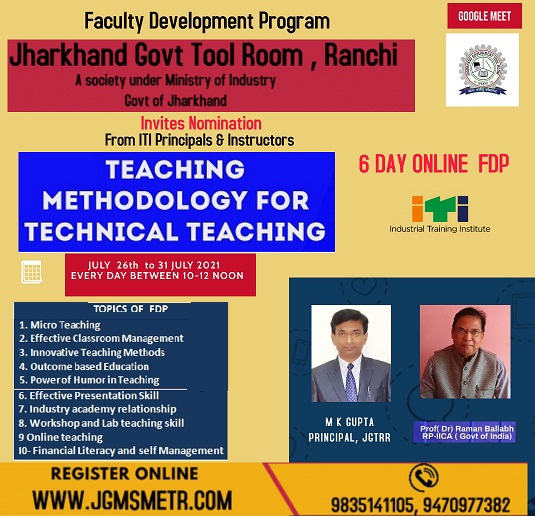 Greeting from Jharkhand Govt Tool Room ,Ranchi (A Society of Department. of Industries, Govt of Jharkhand) The Government of Jharkhand has set up this modern Tool Room & Training Centres with State of The Art Technology at Tatisilwai Ranchi under the supervision of MECON . This institute is aimed for imparting training in the field of design & manufacturing. It is conducting AICTE approved 4 years Diploma in Tool & Die Making course (Equivalent to Diploma in Mechanical) and various industry oriented skill development courses in the area of Machinist, Welder, Fitter, Electrician, CNC, CAD/CAM, TQM, Inspection & Quality Control, 5S, six sigma, CNC Maintenance, PLC Programming , design and manufacturing of moulds, press tools, die casting dies and jigs & fixture, Mobile phone repairing , Computer Hardware & Network Management etc.. We are announcing 06 Days *ONLINE Faculty Development Program* *(FDP)* on *“Teaching Methodology for Technical Education”* to be conducted by Training Department of *Jharkhand Government Tool Room Ranchi from 26th July to 31th July 2021 .* The highlights of the 06 Day ONLINE Faculty Development Program are as follows: Suitability of participants: *This is a common course for Principals, Training Instructors and faculties.* *Fees: Rs 500 INR per Participant* *From: 26th July to 31th July 2021.* *Time: 10:00 AM to 12:00 noon* *Platform: Google Meet* *Faculty Development program (Objective):* The Faculty Development Program strengthens the professional development of the faculty members and administrators who deal directly with students. Our goal is to help these educators increase the effectiveness of their teaching, especially in undergraduate programs, so that they are better able to guide students on journeys of inquiry and discovery. *Main Topics to be covered in the FDP-*
Greeting from Jharkhand Govt Tool Room ,Ranchi (A Society of Department. of Industries, Govt of Jharkhand) The Government of Jharkhand has set up this modern Tool Room & Training Centres with State of The Art Technology at Tatisilwai Ranchi under the supervision of MECON . This institute is aimed for imparting training in the field of design & manufacturing. It is conducting AICTE approved 4 years Diploma in Tool & Die Making course (Equivalent to Diploma in Mechanical) and various industry oriented skill development courses in the area of Machinist, Welder, Fitter, Electrician, CNC, CAD/CAM, TQM, Inspection & Quality Control, 5S, six sigma, CNC Maintenance, PLC Programming , design and manufacturing of moulds, press tools, die casting dies and jigs & fixture, Mobile phone repairing , Computer Hardware & Network Management etc.. We are announcing 06 Days *ONLINE Faculty Development Program* *(FDP)* on *“Teaching Methodology for Technical Education”* to be conducted by Training Department of *Jharkhand Government Tool Room Ranchi from 26th July to 31th July 2021 .* The highlights of the 06 Day ONLINE Faculty Development Program are as follows: Suitability of participants: *This is a common course for Principals, Training Instructors and faculties.* *Fees: Rs 500 INR per Participant* *From: 26th July to 31th July 2021.* *Time: 10:00 AM to 12:00 noon* *Platform: Google Meet* *Faculty Development program (Objective):* The Faculty Development Program strengthens the professional development of the faculty members and administrators who deal directly with students. Our goal is to help these educators increase the effectiveness of their teaching, especially in undergraduate programs, so that they are better able to guide students on journeys of inquiry and discovery. *Main Topics to be covered in the FDP-*

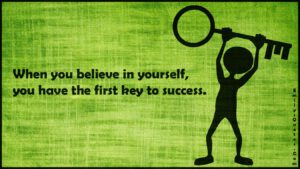 विश्व में हर व्यक्ति हर समय और हर स्थान पर अपनी क्षमता, प्रवृति, विवेक से निर्णय लेता है I गलत निर्णय का परिणाम असफलता अथवा तकलीफ का कारण बन जाता है I इसके विपरीत लिया हुआ सटीक और सही निर्णय उसे प्रगति के मार्ग में आगे ले जाता है I इस लेख के माध्यम यह प्रयास किया गया है कि सही समय, स्थान और परिस्थिति की पहचान करके सर्वोचित निर्णय लेने की कौन-कौन सी प्रमुख कारक हैं जिसे निर्णय लेते वक़्त ध्यान में रखना आवश्यक है ताकि अच्छे परिणाम-युक्त और सही निर्णय लिया जा सके और सफलता हासिल की जा सके I Every day we take decisions on various issues pertaining to our personal, family, social lives and participate in the decision making process with the group of people within the family and/or organization where we are somehow related to and also affect our life-styles directly and/or indirectly. Decisions are taken most often while fulfilling the needs (physiological, esteem, self-actualization, safety, security, organizational and social, etc). First of all, we need to understand our status or position in the decision making process.
विश्व में हर व्यक्ति हर समय और हर स्थान पर अपनी क्षमता, प्रवृति, विवेक से निर्णय लेता है I गलत निर्णय का परिणाम असफलता अथवा तकलीफ का कारण बन जाता है I इसके विपरीत लिया हुआ सटीक और सही निर्णय उसे प्रगति के मार्ग में आगे ले जाता है I इस लेख के माध्यम यह प्रयास किया गया है कि सही समय, स्थान और परिस्थिति की पहचान करके सर्वोचित निर्णय लेने की कौन-कौन सी प्रमुख कारक हैं जिसे निर्णय लेते वक़्त ध्यान में रखना आवश्यक है ताकि अच्छे परिणाम-युक्त और सही निर्णय लिया जा सके और सफलता हासिल की जा सके I Every day we take decisions on various issues pertaining to our personal, family, social lives and participate in the decision making process with the group of people within the family and/or organization where we are somehow related to and also affect our life-styles directly and/or indirectly. Decisions are taken most often while fulfilling the needs (physiological, esteem, self-actualization, safety, security, organizational and social, etc). First of all, we need to understand our status or position in the decision making process.

